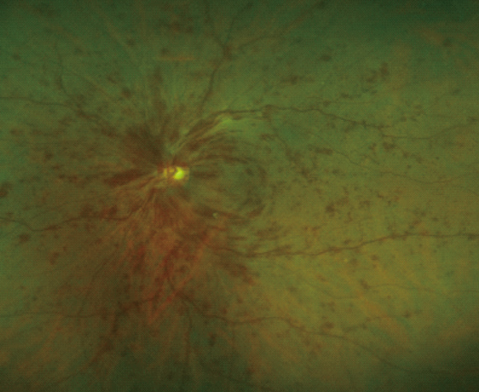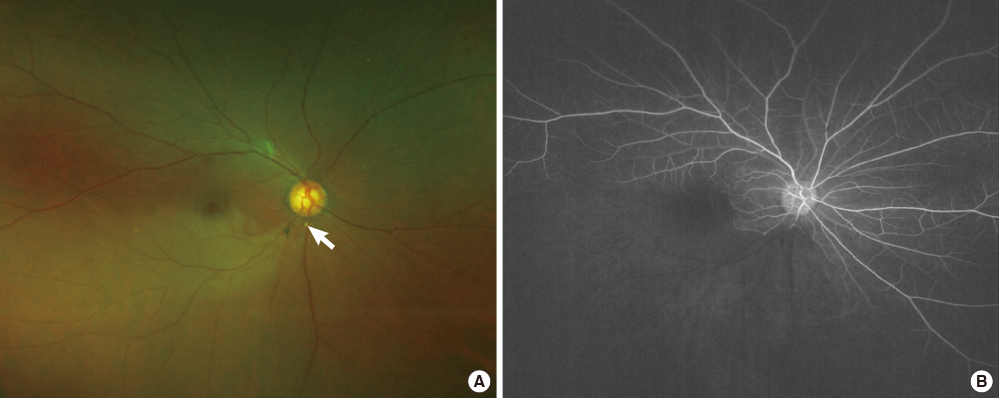Hanyang Med Rev.
2016 Aug;36(3):146-150. 10.7599/hmr.2016.36.3.146.
Window to Heart; Ocular Manifestations of Hypertension
- Affiliations
-
- 1Department of Ophthalmology, College of Medicine, Seoul National University, Seoul, Korea. hgonyu@snu.ac.kr
- 2Department of Experimental Animal Research, Seoul National University Hospital Biomedical Research Institute, Seoul, Korea.
- KMID: 2350363
- DOI: http://doi.org/10.7599/hmr.2016.36.3.146
Abstract
- Systemic hypertension affects not only the heart, kidneys, brain, and large arteries but also the eyes. High blood pressure (BP) causes a series of pathophysiological changes in the retinal vasculature, including focal and diffuse narrowing of the retinal arteriole, opacification of the arteriolar wall, and compression of the venules by arterioles. In severe cases, hemorrhage, nerve fiber layer infraction, and disc swelling can occur. Systemic hypertension results in various retinal vascular diseases, such as hypertensive retinopathy, retinal vein or artery occlusion, retinal arterial macroaneurysm, and nonarteritic ischemic optic neuropathy. High BP also increases the risk of development and progression of diabetic retinopathy. Signs of hypertensive retinopathy are predictive of target-organ damages, including cardiovascular and cerebrovascular diseases. While managing patients with hypertensive retinopathy, physicians should be aware of the management of cardiovascular and cerebrovascular risk factors.
MeSH Terms
Figure
Cited by 1 articles
-
Ocular Manifestations of Systemic Diseases: The Eyes are the Windows of the Body
Heeyoon Cho
Hanyang Med Rev. 2016;36(3):143-145. doi: 10.7599/hmr.2016.36.3.143.
Reference
-
1. Wong TY, Mitchell P. Hypertensive retinopathy. N Engl J Med. 2004; 351:2310–2317.
Article2. Liew G, Campbell S, Klein R, Klein BE, Sharrett AR, Cotch MF, et al. Ten-year longitudinal changes in retinal microvascular lesions: the atherosclerosis risk in communities study. Ophthalmology. 2011; 118:1612–1618.
Article3. Wang JJ, Liew G, Wong TY, Smith W, Klein R, Leeder S, et al. Retinal vascular calibre and the risk of coronary heart disease-related death. Heart. 2006; 92:1583–1587.
Article4. Tso MO, Jampol LM. Pathophysiology of hypertensive retinopathy. Ophthalmology. 1982; 89:1132–1145.
Article5. Parving H. Controlling hypertension in diabetes. Acta Diabetol. 2002; 39:s35–s40.
Article6. Tarnow L, Rossing P, Gall MA, Nielsen FS, Parving HH. Prevalence of arterial hypertension in diabetic patients before and after the JNC-V. Diabetes Care. 1994; 17:1247–1251.
Article7. Zoungas S, de Galan B, Ninomiya T, Grobbee D, Hamet P, Heller S, et al. ADVANCE Collaborative Group Cass A. Glasziou P, Harrap S, Lisheng L, Mancia G, Pillai A, Poulter N, Perkovic V, Travert F. Combined effects of routine blood pressure lowering and intensive glucose control on macrovascular and microvascular outcomes in patients with type 2 diabetes: new results from the ADVANCE trial. Diabetes Care. 2009; 32:2068–2074.
Article8. Wong TY, Klein R, Klein BE, Tielsch JM, Hubbard L, Nieto FJ. Retinal microvascular abnormalities and their relationship with hypertension, cardiovascular disease, and mortality. Surv Ophthalmol. 2001; 46:59–80.
Article9. Keith NM, Wagener HP, Barker NW. Some different types of essential hypertension: their course and prognosis. Am J Med Sci. 1974; 268:336–345.
Article10. Kang S, Roh YJ, Moon JI. Hypertensive retinopathy and associated target organ damage in Korean hypertensive patients. J Korean Ophthalmol Soc. 2010; 51:1231–1236.
Article11. David R, Zangwill L, Badarna M, Yassur Y. Epidemiology of retinal vein occlusion and its association with glaucoma and increased intraocular pressure. Ophthalmologica. 1988; 197:69–74.
Article12. Klein R, Klein BE, Moss SE, Meuer SM. The epidemiology of retinal vein occlusion: the Beaver Dam Eye Study. Trans Am Ophthalmol Soc. 2000; 98:133–143.13. Rogers SL, McIntosh RL, Lim L, Mitchell P, Cheung N, Kowalski JW, et al. Natural history of branch retinal vein occlusion: an evidence-based systematic review. Ophthalmology. 2010; 117:1094–1101.e5.
Article14. McIntosh RL, Rogers SL, Lim L, Cheung N, Wang JJ, Mitchell P, et al. Natural history of central retinal vein occlusion: an evidence-based systematic review. Ophthalmology. 2010; 117:1113–1123.e15.
Article15. Hollenhorst RW. Significance of bright plaques in the retinal arterioles. JAMA. 1961; 178:23–29.
Article16. Wong TY, Klein R. Retinal arteriolar emboli: epidemiology and risk of stroke. Curr Opin Ophthalmol. 2002; 13:142–146.
Article17. Mitchell P, Wang JJ, Li W, Leeder SR, Smith W. Prevalence of asymptomatic retinal emboli in an Australian urban community. Stroke. 1997; 28:63–66.
Article18. Klein R, Klein BE, Jensen SC, Moss SE, Meuer SM. Retinal emboli and stroke: The beaver dam eye study. Arch Ophthalmol. 1999; 117:1063–1068.19. Klein R, Klein BE, Moss SE, Meuer SM. Retinal emboli and cardiovascular disease: the Beaver Dam Eye Study. Arch Ophthalmol. 2003; 121:1446–1451.20. Marcucci R, Sodi A, Giambene B, Liotta AA, Poli D, Mannini L, et al. Cardiovascular and thrombophilic risk factors in patients with retinal artery occlusion. Blood Coagul Fibrinolysis. 2007; 18:321–326.
Article21. Wong TY, Klein R, Sharrett AR, Duncan BB, Couper DJ, Tielsch JM, et al. Retinal arteriolar narrowing and risk of coronary heart disease in men and women: the Atherosclerosis Risk in Communities Study. JAMA. 2002; 287:1153–1159.22. Hattenhauer MG, Leavitt JA, Hodge DO, Grill R, Gray DT. Incidence of Nonarteritic Anteripr Ischemic Optic Neuropathy. Am J Ophthalmol. 1997; 123:103–107.
Article23. Group IONDTS. Characteristics of patients with nonarteritic anterior ischemic optic neuropathy eligible for the Ischemic Optic Neuropathy Decompression Trial. Arch Ophthalmol. 1996; 114:1366–1374.24. Hsueh WA, Anderson PW. Hypertension, the endothelial cell, and the vascular complications of diabetes mellitus. Hypertension. 1992; 20:253–263.
Article25. Suzuma I, Hata Y, Clermont A, Pokras F, Rook SL, Suzuma K, et al. Cyclic Stretch and Hypertension Induce Retinal Expression of Vascular Endothelial Growth Factor and Vascular Endothelial Growth Factor Receptor—2 Potential Mechanisms for Exacerbation of Diabetic Retinopathy by Hypertension. Diabetes. 2001; 50:444–454.
Article26. Matthews DR. Group UPDS. Risks of progression of retinopathy and vision loss related to tight blood pressure control in type 2 diabetes mellitus: UKPDS 69. Arch Ophthalmol. 2004; 122:1631–1640.
Article27. Gillum RF. Retinal arteriolar findings and coronary heart disease. Am Heart J. 1991; 122:262–263.
Article28. Duncan B, Wong T, Tyroler H, Davis C, Fuchs F. Hypertensive retinopathy and incident coronary heart disease in high risk men. Br J Ophthalmol. 2002; 86:1002–1006.
Article29. Wong TY, Larsen EKM, Klein R, Mitchell P, Couper DJ, Klein BE, et al. Cardiovascular risk factors for retinal vein occlusion and arteriolar emboli: the Atherosclerosis Risk in Communities & Cardiovascular Health studies. Ophthalmology. 2005; 112:540–547.
Article30. Wong TY, Klein R, Couper DJ, Cooper LS, Shahar E, Hubbard LD, et al. Retinal microvascular abnormalities and incident stroke: the Atherosclerosis Risk in Communities Study. Lancet. 2001; 358:1134–1140.
Article31. Wong TY, Klein R, Nieto FJ, Klein BE, Sharrett AR, Meuer SM, et al. Retinal microvascular abnormalities and 10-year cardiovascular mortality: a population-based case-control study. Ophthalmology. 2003; 110:933–940.
Article32. Nakayama T, Date C, Yokoyama T, Yoshiike N, Yamaguchi M, Tanaka H. A 15.5-year follow-up study of stroke in a Japanese Provincial City The Shibata Study. Stroke. 1997; 28:45–52.
Article
- Full Text Links
- Actions
-
Cited
- CITED
-
- Close
- Share
- Similar articles
-
- Perioperative Anesthetic Management of Acute Heart Failure in a Patient with Takayasu's Arteritis Accompanied by Renovascular Hypertension
- Ocular Hypertension
- A Case of Ocular Rosacea
- Risk Factors and Clinical Manifestations of Ocular Hypertension after Primary Repair of Open Globe Injury
- Ocular Manifestations of Pediatric Systemic Disease




